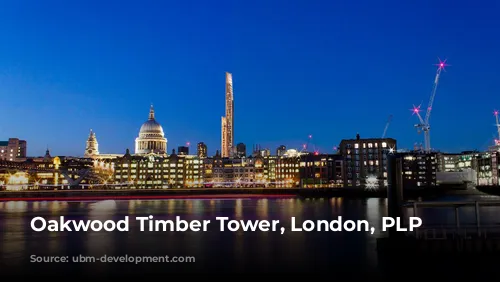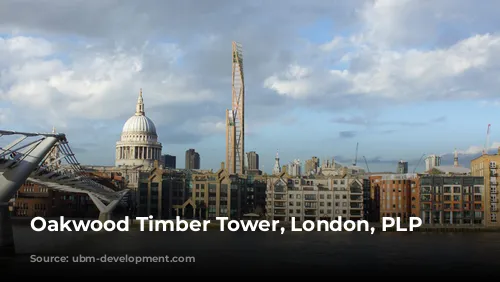London, a city known for its iconic landmarks and architectural prowess, is about to witness a groundbreaking feat in construction. Imagine a skyscraper reaching for the sky, not built from steel and glass, but from the humble yet extraordinary material – wood. This vision is coming to life with the Oakwood Timber Tower, a 300-meter-tall behemoth that aims to reshape London’s skyline while championing sustainability.
The ambitious project is not just about building tall; it’s about creating a monument to sustainable architecture. Nestled amidst the concrete legacy of the Barbican Estate, the Oakwood Timber Tower will stand as a testament to the power of renewable resources. It symbolizes a shift away from the CO2-intensive materials of the past and embraces a future where wood reigns supreme.
A Journey from Concept to Reality
While the idea of a wooden skyscraper may evoke wonder and excitement, the journey from concept to reality is a demanding one. A team of scientists, engineers, and architects are meticulously researching every aspect of the project, from the microscopic structure of wood to the tower’s ability to withstand the harshest winds.
Their mission is clear: to champion the use of wood as the preferred construction material for high-rise buildings. Experts worldwide are increasingly recognizing the potential of wood, a renewable resource with exceptional properties. Beyond its ability to absorb CO2 during growth, wood boasts outstanding strength, low weight, and a high degree of prefabrication, leading to faster construction times.

Breaking Records and Redefining Limits
The Oakwood Timber Tower aims to set a new benchmark for timber construction, surpassing the 100-meter mark already achieved by projects like Berlin’s WoHo and Eindhoven’s Dutch Mountains. With its towering height of 300 meters, it will nearly match the Shard, the current tallest skyscraper in London.
The key to this audacious project lies in cross-laminated timber (CLT), a revolutionary material gaining popularity since the 1990s. Countries like Austria and Germany are leading the charge in CLT production, solidifying its position as a booming industry.
A Revolution in Building
Kevin Flanagan, the lead architect of the Oakwood Timber Tower project, emphasizes the transformative power of CLT. He describes how CLT panels can be assembled much faster, quieter, and with fewer workers compared to traditional concrete construction. The lightweight nature of wood offers significant advantages in urban development.
Flanagan points out that timber buildings, due to their lighter weight, require less extensive foundations, making them ideal for sites with underground infrastructure like tunnels, common in bustling cities. The Oakwood Timber Tower, for example, will be roughly a quarter of the weight of a similar concrete structure.
Addressing Concerns, Embracing Innovation
While the concept of a wooden skyscraper might raise concerns about fire safety, Flanagan assures us that the project adheres to stringent regulations. The design incorporates CLT, which not only provides a superior level of quality control but also enhances fire protection.
For Flanagan and his team, the construction of wooden skyscrapers marks a new era in architecture. Just as steel, glass, and concrete revolutionized building in the past, wood is poised to redefine the cityscape in the 21st century. The Oakwood Timber Tower is not just a building; it’s a symbol of innovation, sustainability, and the boundless possibilities of nature.









